
12 Best Lunch Spots In Napa
Best Lunch In Napa – Our 12 Favorite Spots! Lunch is a must when you’re out wine tasting! Whether you’re in the mood for a

What do you think of when you hear the word “Sweet Wines”?
In truth, sweet wines are all of the above. Because they can satisfy all different types of wine drinkers (from a wine novice to a wine enthusiast). And they can range in cost from very cheap to very expensive. In fact high quality sweet wines are trending up due to their versatility of pairing with many different styles of food.
So in this post, let’s discuss everything you need to know about sweet wines.
Typically if a wine contains over 30 grams/liter residual sugar, it’s a sweet wine.
Sweet wines, sometimes described as dessert wines, are simply sweet-tasting wines. And they can vary from low-level sweet notes to thick, syrupy texture and heavily sweet flavors. Plus they can be either sparkling or still, and their sweetness levels can range from very sweet to off-dry.
And although sweet white wine options tend to be popular, sweet red wines also have their fans.
In addition to its sweet taste, sweet wine has several other benefits including better preservation due to the higher sugar content and ease of matching with desserts.
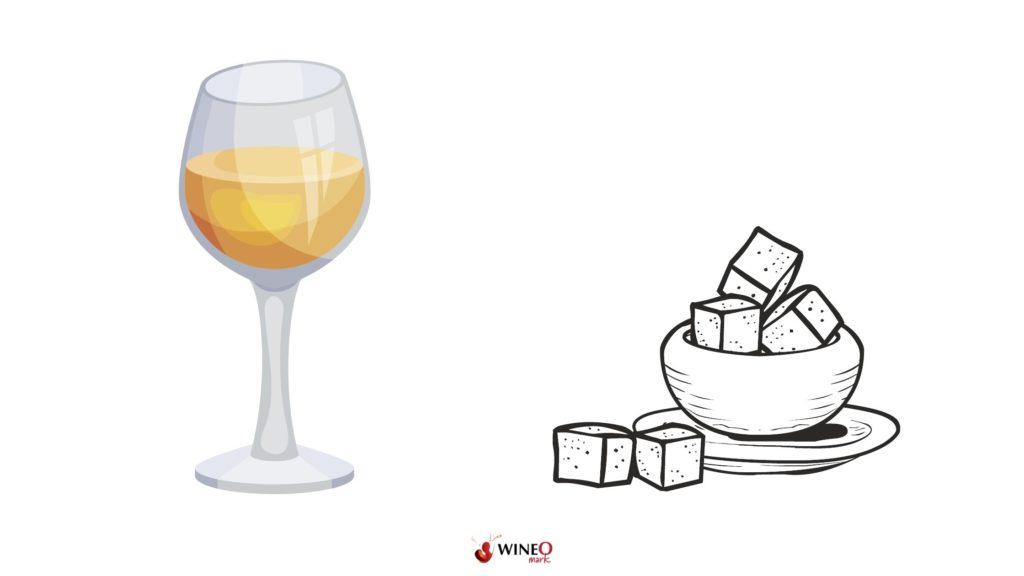
There are a variety of methods to make sweet wines:
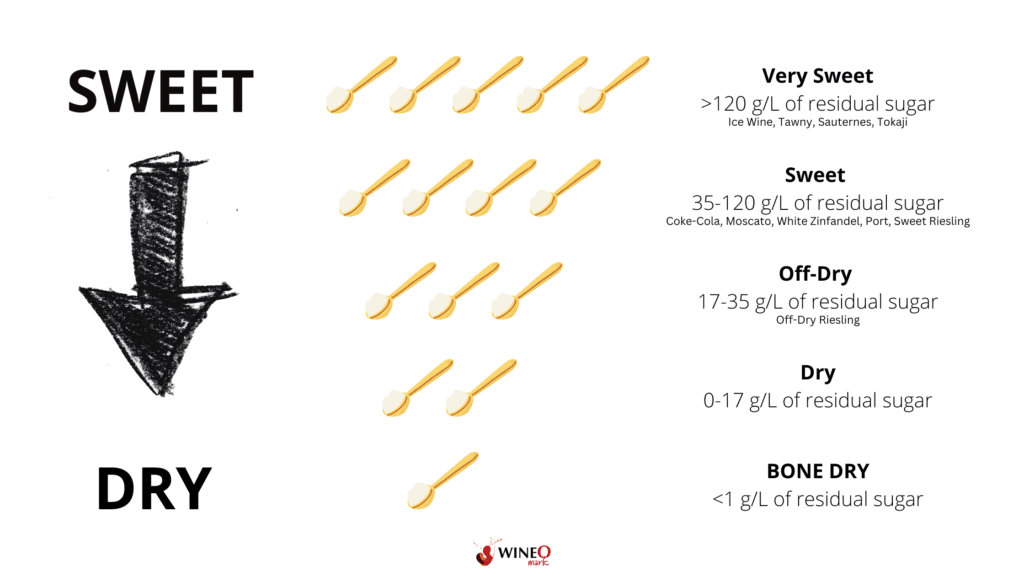
*Coca-Cola has ~115 g/L of residual sugar
120–220 g/L of residual sugar
Grown in the Sauternes region of Bordeaux, this wine is made from Sémillon, Sauvignon Blanc, and Muscadelle grapes.
This sweet, dessert-style white wine has a rich golden color and thick viscosity. And its distinctive taste is created through the special method used to produce Sauternes: the grapes are left on the vine longer than usual in order to become infected with Botrytis Cinerea, more commonly known as “noble rot.”
And this fungus gives Sauternes its unique taste, enhanced by hints of peach, honey, caramel and apricot. As a result, it tastes best when paired with equally sweet desserts like pecan pie, pear tart or creme brulée.
Producing wines from the renowned Sauternes region, especially Premier Cru Supérieur Château d’Yquem is extremely costly – making it one of the world’s most expensive sweet wines.
90 – 120g/L of Residual Sugar
Port wine is a sweet, fortified red or white wine. And they are produced in Douro Valley (Northern Portugal). It’s a sweet, full-bodied wine that is typically made from a variety of grapes, including Tinta Barroca, Touriga Francesca, and Touriga Nacional. And then mixed with a spirit of brandy to add strength and flavor. Because of this fortification, it prevents the fermentation process from continuing which is how port retains its sweetness.
Also, its usually 19 to 20 percent alcohol and produces aromas of ripe fruits and spices. And it can range from ruby port which is light and sweet to tawny port which is darker and richer. Additionally, this wine is an excellent accompaniment for desserts, cheese, and chocolate.
Regarded as the “King” among ports, Vintage Port is widely acclaimed to be the finest and most expensive type of port. And most vintage ports should be permitted to age and mature to its peak for 20-40+ years before drinking.
90–100 g/L of Residual Sugar
Moscato d’Asti is an aromatic sparkling wine produced in the Piedmont region of Italy. And its a naturally-occurring sweet wine, made from Moscato Bianco grapes, and characterized by its delicate balance of sweetness and effervescence. Typically, it has just 5-6% alcohol.
And this wine has gained international fame over the past few decades, thanks to its fresh and harmonious fruity aromas with a delightful aftertaste.
Because it offers a light sweetness combined with zesty bubbles, it makes for the perfect refreshing option on warm Spring or Summer days. Additionally, enjoy it with various desserts, or simply on its own as an after dinner treat.
90-220g/L of Residual Sugar
Sweet Riesling has a tight balance of sweetness and acidity and it is characterized by aromas of apples, candied citrus fruits, floral notes, stone fruits, tropical fruits and honey. And it tastes fresh, fruity and vibrant on the palate with clear distinctions between sweet flavor components like peach and apricot, and the tart acidity that cuts through each sip.
These wines are naturally low in alcohol content and offer an approachable profile that appeals to all levels of wine drinkers–from beginners to experts.
Below is our translation, so next time you pick up a German Riesling you know exactly what you are getting.
180-320g/L of Residual Sugar
Ice wine is a type of dessert wine made from grapes that freeze on the vine. And this freezing process concentrates the sugar and acids, which gives the ice wine a distinctively sweet and flavorful taste. Furthermore, the ice must remain frozen until it is pressed in order to produce ice wine, so ice wines are generally only produced in areas where temperatures can stay reliably cold during the winter months, such as Canada and Germany.
And due to its intense balance of flavors, it has a honey-like smoothness.
120-450g/L of Residual Sugar
Tokaji Aszu has long been recognized as one of the greatest sweet wines in the world. And it was famously referred to by Louis XIV of France as “the King of wines, and the wine of Kings.”
Plus it’s a world-renowned Hungarian dessert wine made from Furmint and Hárslevelű grapes in Tokaj-Hegyalja, an area of northern Hungary classified as a World Heritage Site by UNESCO.
Tokaji Aszu is characterized by its rich and complex flavor profile, often described as having notes of dried fruit, honey, apricots, dates, cedar, orange peel and roses. This wine continues to hold a revered position among food connoisseurs around the world.
Invented in the 1970s, this wine quickly became a favorite in the 1980s and 1990s. But then it had a decline in popularity. However, it introduced wine to many Americans. Currently, there is still a market for this type of wine; however, it only comprises a very small percentage of the total wine market.
It’s a blush-style wine, meaning it has a subtle pink hue with vibrant sweet notes of berry and citrus.
Although sweet wine is usually associated with white wines, sweet red wines are also available.
Sweet reds typically have notes of sweet plum, cherry and raspberry flavors. And some of the most popular sweet reds include Port, Lambrusco, Brachetto, Dornfelder, Recioto Della Valpolicella, etc…
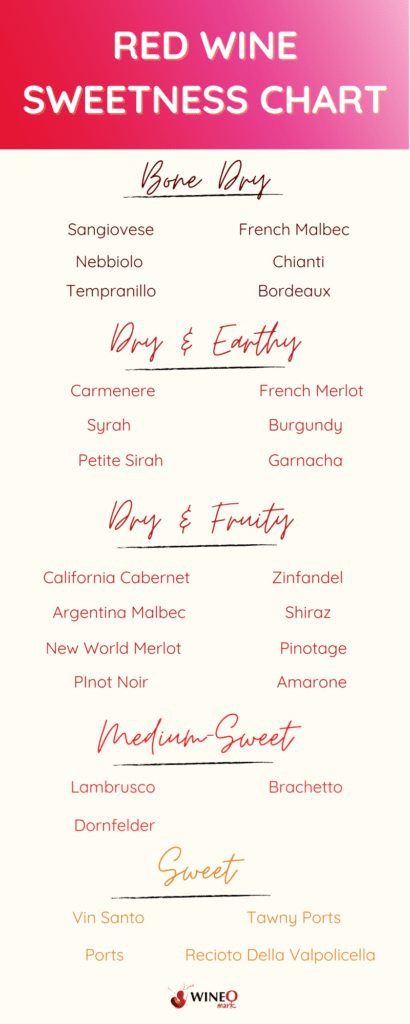
Sweet white wines tend to be the most popular sweet wines with a range of styles and flavors.
Common sweet white wine varietals include Riesling, Moscato, Gewurztraminer and Chenin Blanc. These sweet white wines usually have notes of tropical fruit, melon, honey and citrus.
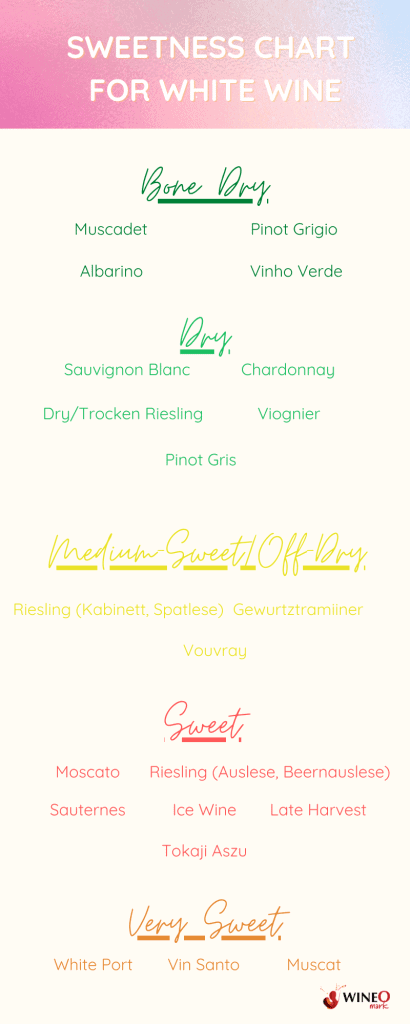
The sweetest wines can typically be sweet Riesling, Tokaji Aszu, sweet sherry, Sauternes, and Ice Wine.
Riesling is sweet, light-bodied and easy to drink. It’s a good sweet wine for beginners who are looking to get into sweet wines. And it pairs well with food.

Best Lunch In Napa – Our 12 Favorite Spots! Lunch is a must when you’re out wine tasting! Whether you’re in the mood for a

North Coast Wine Co. Outerbound Pinot Noir – WineO Mark Review Wine Stats Grape Variety: 100% Pinot Noir Vintage: 2019 ABV: 14% Wine Region: North Coast,
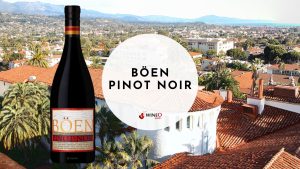
Böen Pinot Noir – WineO Mark Review Wine Stats Grape Variety: 100% Pinot Noir Vintage: 2021 ABV: 14.6% Wine Region: California Flavor Profile: Cherry, raspberry, blackberry,

Merry Edwards Sauvignon Blanc – WineO Mark Review Wine Stats Grape Variety: 100% Sauvignon Blanc Vintage: 2022 ABV: 14% Wine Region: Russian River Valley, California
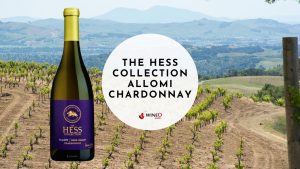
The Hess Collection Allomi Chardonnay – WineO Mark Review Wine Stats Grape Variety: 100% Chardonnay Vintage: 2019 ABV: 14.3% Wine Region: Napa Valley, California Flavor Profile:

Stags’ Leap Chardonnay – WineO Mark Review Wine Stats Grape Variety: 100% Chardonnay Vintage: 2022 ABV: 14.1% Wine Region: Napa Valley, California Flavor Profile: Oak, vanilla,

Godeval Cepas Vellas Godello – WineO Mark Review Wine Stats Grape Variety: 100% Godello Vintage: 2021 ABV: 13% Wine Region: Valdeorras, Spain Flavor Profile: Peach,

Félix Solís Mucho Más Tinto N.V. – WineO Mark Review Wine Stats Grape Variety: Tempranillo, Syrah Vintage: Non-Vintage ABV: 14% Wine Region: Spain Flavor Profile: Vanilla,
